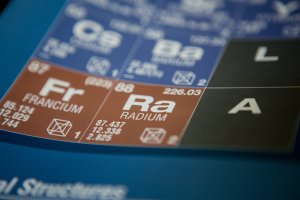Marie Curie: Discovering New Elements1
 Marie Curie’s groundbreaking discoveries in radioactivity helped change the landscape in the field of radioactivity. Along with her husband Pierre Curie, she was intrigued by the newly discovered phenomenon of “invisible rays” emitted by uranium. Their work led to the discovery of two new radioactive elements: polonium and radium. She became the first woman to earn a Nobel Prize and would become the first person to win two Nobel Prizes. Marie Curie’s discoveries in radioactivity paved the way for countless applications in medicine, physics, and other fields.
Marie Curie’s groundbreaking discoveries in radioactivity helped change the landscape in the field of radioactivity. Along with her husband Pierre Curie, she was intrigued by the newly discovered phenomenon of “invisible rays” emitted by uranium. Their work led to the discovery of two new radioactive elements: polonium and radium. She became the first woman to earn a Nobel Prize and would become the first person to win two Nobel Prizes. Marie Curie’s discoveries in radioactivity paved the way for countless applications in medicine, physics, and other fields.
Marie Maynard Daly: Unraveling the Mysteries of Cholesterol2
 Marie Maynard Daly made history as the first Black woman to receive a Ph.D. in chemistry. Her research focused on cholesterol, sugars, and proteins and, through her meticulous studies, she identified various types of cholesterol and their distinct behaviors, laying the foundation for future diagnostic and treatment breakthroughs. Dr. Daly was a professor for many years at various universities and supported programs to increase minority students’ enrollment in graduate science programs and the field of medicine.
Marie Maynard Daly made history as the first Black woman to receive a Ph.D. in chemistry. Her research focused on cholesterol, sugars, and proteins and, through her meticulous studies, she identified various types of cholesterol and their distinct behaviors, laying the foundation for future diagnostic and treatment breakthroughs. Dr. Daly was a professor for many years at various universities and supported programs to increase minority students’ enrollment in graduate science programs and the field of medicine.
Dorothy Hodgkin: Unveiling the Secrets of Life’s Molecules3
 Dorothy Hodgkin was a British chemist whose work in X-ray crystallography helped to revolutionize our understanding of life’s molecules. Her discoveries include confirming the structure of penicillin, which was a crucial step in understanding its antibiotic properties. She unraveled the structure of vitamin B12, which shed light on its role in metabolism and the nervous system; and determined the structure of insulin, revolutionizing the treatment of diabetes. These accomplishments earned her the Nobel Prize in Chemistry, becoming the third woman to receive the award.
Dorothy Hodgkin was a British chemist whose work in X-ray crystallography helped to revolutionize our understanding of life’s molecules. Her discoveries include confirming the structure of penicillin, which was a crucial step in understanding its antibiotic properties. She unraveled the structure of vitamin B12, which shed light on its role in metabolism and the nervous system; and determined the structure of insulin, revolutionizing the treatment of diabetes. These accomplishments earned her the Nobel Prize in Chemistry, becoming the third woman to receive the award.
Stephanie Kwolek: An Accidental Discovery4
 In 1965, Stephanie Kwolek’s accidental invention of Kevlar® led to the creation of synthetic fibers that are used in bullet proof vests. Today, Kevlar® is used in a wide range of products—from spacecrafts and helmets to tennis rackets and tires. Kwolek’s invention continues to protect the lives of first responders and others who benefit from the material’s heat-resistance and exceptional strength.
In 1965, Stephanie Kwolek’s accidental invention of Kevlar® led to the creation of synthetic fibers that are used in bullet proof vests. Today, Kevlar® is used in a wide range of products—from spacecrafts and helmets to tennis rackets and tires. Kwolek’s invention continues to protect the lives of first responders and others who benefit from the material’s heat-resistance and exceptional strength.
As we celebrate Women’s History Month, let’s remember and honor the contributions these women and many others have made to advance chemistry, and continue to encourage and empower the next generation of female chemists to make their marks on the world.




